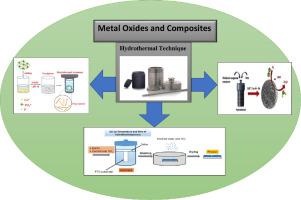从研究和商业的角度来看,超级电容器作为一种电化学储能装置都引起了极大的兴趣。这种独特的设备以高功率密度和长循环寿命而闻名。因此,配备在从微型便携式电子设备到混合动力电动汽车的多种应用中。电极材料在超级电容器的电化学性能中起着重要作用,其中过渡金属氧化物及其复合材料是研究最多的材料。电极材料的明确形态主要依赖于制造中使用的合成技术。例如,水热技术就是一种用于形成超级电容器电极的通用方法。它便宜、简单、环保,并允许很好地定义具有各种尺寸和确定的孔径分布的结晶形态。尽管该方法已在超级电容器研究中大规模使用,但详细共享的知识很少,总结了该技术的背景、效用和范围。本综述深入探讨了该技术在超级电容器研究中合成各种金属氧化物/氢氧化物及其复合材料方面的重要贡献。已经探索了提供具有关键方面的性能评估的最佳示例。此外,该技术的优缺点也得到了强调。本综述的主要目的是利用该技术在超级电容器开发中的当前发现探索未来的范围。该方法已在超级电容器研究中大规模使用,但详细分享的知识很少,总结了该技术的背景、效用和范围。本综述深入探讨了该技术在超级电容器研究中合成各种金属氧化物/氢氧化物及其复合材料方面的重要贡献。已经探索了提供具有关键方面的性能评估的最佳示例。此外,该技术的优点和缺点也得到了强调。本综述的主要目的是利用该技术在超级电容器开发中的当前发现探索未来的范围。该方法已在超级电容器研究中大规模使用,但详细分享的知识很少,总结了该技术的背景、效用和范围。本综述深入探讨了该技术在超级电容器研究中合成各种金属氧化物/氢氧化物及其复合材料方面的重要贡献。已经探索了提供具有关键方面的性能评估的最佳示例。此外,该技术的优点和缺点也得到了强调。本综述的主要目的是利用该技术在超级电容器开发中的当前发现探索未来的范围。本综述深入探讨了该技术在超级电容器研究中合成各种金属氧化物/氢氧化物及其复合材料方面的重要贡献。已经探索了提供具有关键方面的性能评估的最佳示例。此外,该技术的优缺点也得到了强调。本综述的主要目的是利用该技术在超级电容器开发中的当前发现探索未来的范围。本综述深入探讨了该技术在超级电容器研究中合成各种金属氧化物/氢氧化物及其复合材料方面的重要贡献。已经探索了提供具有关键方面的性能评估的最佳示例。此外,该技术的优点和缺点也得到了强调。本综述的主要目的是利用该技术在超级电容器开发中的当前发现探索未来的范围。
 "点击查看英文标题和摘要"
"点击查看英文标题和摘要"
Importance and challenges of hydrothermal technique for synthesis of transition metal oxides and composites as supercapacitor electrode materials
Supercapacitor as an electrochemical energy storage device is of huge interest from both research as well as commercial point of view. This unique device is well known for high power density and long cycle life. Therefore, equipped in several applications ranging from miniature portable electronics to hybrid electric vehicles. Electrode materials play a major role in the electrochemical performance of supercapacitors, amongst which transition metal oxides and their composites are the most explored ones. A well-define morphology of electrode materials relies majorly on the synthesis technique used in the fabrication. For example, hydrothermal technique is one such versatile approach for the formation of supercapacitor electrodes. It is inexpensive, simple, eco-friendly, and allows well define crystalline morphologies with various dimensions and definite pore size distributions. Although, the method has been utilized at a large scale in supercapacitor research, very little knowledge has been shared in detail, summarising the background, utility, and scope of this technique. This review in-depth focuses on the esteemed contribution made by this technique in the synthesis of various metal oxides/hydroxides and their composites in supercapacitor research. The best examples, providing performance evaluation with critical aspects have been explored. Also, the merits and demerits of this technique have been highlighted. Exploring the future scope with the current findings of this technology in supercapacitor development is the main purpose of this review.

































 京公网安备 11010802027423号
京公网安备 11010802027423号